Abstract
Objective
To identify the risk factors of lymphocele formation in patients with cervical cancer who underwent radical abdominal hysterectomy and pelvic lymph node dissection.
Methods
We conducted a retrospective study of 62 patients diagnosed with cervical cancer who underwent radical abdominal hysterectomy, including pelvic lymph node dissection between April 2005 and June 2010. Lymphocele was confirmed by imaging studies such as computed tomography or ultrasonography. Included risk factors were patient's age, body mass index, surgeon's experience, tumor histology, stage of cancer, previous surgery, number of retrieved lymph nodes, and radiation therapy. Multiple logistic regression analysis was performed to evaluate the risk factors of lymphocele formation.
Results
During median follow-up of 34.5 months (range, 12-69 months), 20 patients (32%) out of 62 had developed lymphocele. Eight patients developed symptomatic lymphocle. Univariate analysis showed the radiation therapy, and the number of retrieved lymph nodes as significant risk factors of lymphocele formation. When applying mutivariate analysis using logistic regression, radiation therapy (odds ratio=5.19, p=0.010) and the number of retrieved lymph node (odds ratio=4.80, p=0.021) were independent risk factors of lymphocele formation.
Figures and Tables
References
1. Ohba Y, Todo Y, Kobayashi N, Kaneuchi M, Watari H, Takeda M, et al. Risk factors for lower-limb lymphedema after surgery for cervical cancer. Int J Clin Oncol. 2011. 16:238–243.
2. Matsuda T, Marugame T, Kamo K, Katanoda K, Ajiki W, Sobue T, et al. Cancer incidence and incidence rates in Japan in 2003: based on data from 13 population-based cancer registries in the Monitoring of Cancer Incidence in Japan (MCIJ) Project. Jpn J Clin Oncol. 2009. 39:850–858.
3. Musch M, Klevecka V, Roggenbuck U, Kroepfl D. Complications of pelvic lymphadenectomy in 1,380 patients undergoing radical retropubic prostatectomy between 1993 and 2006. J Urol. 2008. 179:923–928.
4. Briganti A, Chun FK, Salonia A, Suardi N, Gallina A, Da Pozzo LF, et al. Complications and other surgical outcomes associated with extended pelvic lymphadenectomy in men with localized prostate cancer. Eur Urol. 2006. 50:1006–1013.
5. Naselli A, Andreatta R, Introini C, Fontana V, Puppo P. Predictors of symptomatic lymphocele after lymph node excision and radical prostatectomy. Urology. 2010. 75:630–635.
6. Augustin H, Hammerer P, Graefen M, Palisaar J, Noldus J, Fernandez S, et al. Intraoperative and perioperative morbidity of contemporary radical retropubic prostatectomy in a consecutive series of 1243 patients: results of a single center between 1999 and 2002. Eur Urol. 2003. 43:113–118.
7. Suzuki M, Ohwada M, Sato I. Pelvic lymphocysts following retroperitoneal lymphadenectomy: retroperitoneal partial "no-closure" for ovarian and endometrial cancers. J Surg Oncol. 1998. 68:149–152.
8. Hakenberg OW. The incidence and treatment of lymphoceles after radical retropubic prostatectomy. BJU Int. 2005. 96:1422.
9. Kim JK, Jeong YY, Kim YH, Kim YC, Kang HK, Choi HS. Postoperative pelvic lymphocele: treatment with simple percutaneous catheter drainage. Radiology. 1999. 212:390–394.
10. Fallick ML, Long JP. Laparoscopic marsupialization of lymphocele after laparoscopic lymph node dissection. J Endourol. 1996. 10:533–534.
11. Gilliland JD, Spies JB, Brown SB, Yrizarry JM, Greenwood LH. Lymphoceles: percutaneous treatment with povidone-iodine sclerosis. Radiology. 1989. 171:227–229.
12. Sawhney R, D'Agostino HB, Zinck S, Rose SC, Kinney TB, Oglevie SB, et al. Treatment of postoperative lymphoceles with percutaneous drainage and alcohol sclerotherapy. J Vasc Interv Radiol. 1996. 7:241–245.
13. Zanetta G, Trio D, Lissoni A, Dalla Valle C, Rangoni G, Pittelli M, et al. Early and short-term complications after US-guided puncture of gynecologic lesions: evaluation after 1,000 consecutive cases. Radiology. 1993. 189:161–164.
14. Yamamoto R, Saitoh T, Kusaka T, Todo Y, Takeda M, Okamoto K, et al. Prevention of lymphocyst formation following systematic lymphadenectomy. Jpn J Clin Oncol. 2000. 30:397–400.
15. Kang SH, Hwang KH, Sim YJ, Jeong HJ, Lee TH, Kim SH. The prevalence and risk factors of lower limb lymphedema in the patients with gynecologic neoplasms. Korean J Obstet Gynecol. 2009. 52:815–820.
16. Heidenreich A, Varga Z, Von Knobloch R. Extended pelvic lymphadenectomy in patients undergoing radical prostatectomy: high incidence of lymph node metastasis. J Urol. 2002. 167:1681–1686.
17. Clark T, Parekh DJ, Cookson MS, Chang SS, Smith ER Jr, Wells N, et al. Randomized prospective evaluation of extended versus limited lymph node dissection in patients with clinically localized prostate cancer. J Urol. 2003. 169:145–147.
18. Khoder WY, Trottmann M, Buchner A, Stuber A, Hoffmann S, Stief CG, et al. Risk factors for pelvic lymphoceles post-radical prostatectomy. Int J Urol. 2011. 18:638–643.
19. Ryan M, Stainton MC, Jaconelli C, Watts S, MacKenzie P, Mansberg T. The experience of lower limb lymphedema for women after treatment for gynecologic cancer. Oncol Nurs Forum. 2003. 30:417–423.
20. Abu-Rustum NR, Alektiar K, Iasonos A, Lev G, Sonoda Y, Aghajanian C, et al. The incidence of symptomatic lower-extremity lymphedema following treatment of uterine corpus malignancies: a 12-year experience at Memorial Sloan-Kettering Cancer Center. Gynecol Oncol. 2006. 103:714–718.
21. Werngren-Elgström M, Lidman D. Lymphoedema of the lower extremities after surgery and radiotherapy for cancer of the cervix. Scand J Plast Reconstr Surg Hand Surg. 1994. 28:289–293.
22. Füller J, Guderian D, Köhler C, Schneider A, Wendt TG. Lymph edema of the lower extremities after lymphadenectomy and radiotherapy for cervical cancer. Strahlenther Onkol. 2008. 184:206–211.
23. Gallotta V, Fanfani F, Rossitto C, Vizzielli G, Testa A, Scambia G, et al. A randomized study comparing the use of the Ligaclip with bipolar energy to prevent lymphocele during laparoscopic pelvic lymphadenectomy for gynecologic cancer. Am J Obstet Gynecol. 2010. 203:483.e1–483.e6.
24. Kim HY, Kim JW, Kim SH, Kim YT, Kim JH. An analysis of the risk factors and management of lymphocele after pelvic lymphadenectomy in patients with gynecologic malignancies. Cancer Res Treat. 2004. 36:377–383.
25. Franchi M, Trimbos JB, Zanaboni F, v d Velden J, Reed N, Coens C, et al. Randomised trial of drains versus no drains following radical hysterectomy and pelvic lymph node dissection: a European Organisation for Research and Treatment of Cancer-Gynaecological Cancer Group (EORTC-GCG) study in 234 patients. Eur J Cancer. 2007. 43:1265–1268.
26. Benedetti-Panici P, Maneschi F, Cutillo G, D'Andrea G, di Palumbo VS, Conte M, et al. A randomized study comparing retroperitoneal drainage with no drainage after lymphadenectomy in gynecologic malignancies. Gynecol Oncol. 1997. 65:478–482.
27. Srisomboon J, Phongnarisorn C, Suprasert P, Cheewakriangkrai C, Siriaree S, Charoenkwan K. A prospective randomized study comparing retroperitoneal drainage with no drainage and no peritonization following radical hysterectomy and pelvic lymphadenectomy for invasive cervical cancer. J Obstet Gynaecol Res. 2002. 28:149–153.
28. Morice P, Lassau N, Pautier P, Haie-Meder C, Lhomme C, Castaigne D. Retroperitoneal drainage after complete Para-aortic lymphadenectomy for gynecologic cancer: a randomized trial. Obstet Gynecol. 2001. 97:243–247.
29. Abu-Rustum NR, Barakat RR. Observations on the role of circumflex iliac node resection and the etiology of lower extremity lymphedema following pelvic lymphadenectomy for gynecologic malignancy. Gynecol Oncol. 2007. 106:4–5.
30. Park NY, Seong WJ, Chong GO, Hong DG, Cho YL, Park IS, et al. The effect of nonperitonization and laparoscopic lymphadenectomy for minimizing the incidence of lymphocyst formation after radical hysterectomy for cervical cancer. Int J Gynecol Cancer. 2010. 20:443–448.
31. Tinelli A, Giorda G, Manca C, Pellegrino M, Prudenzano R, Guido M, et al. Prevention of lymphocele in female pelvic lymphadenectomy by a collagen patch coated with the human coagulation factors: a pilot study. J Surg Oncol. 2012. 105:835–840.




 PDF
PDF ePub
ePub Citation
Citation Print
Print





 XML Download
XML Download